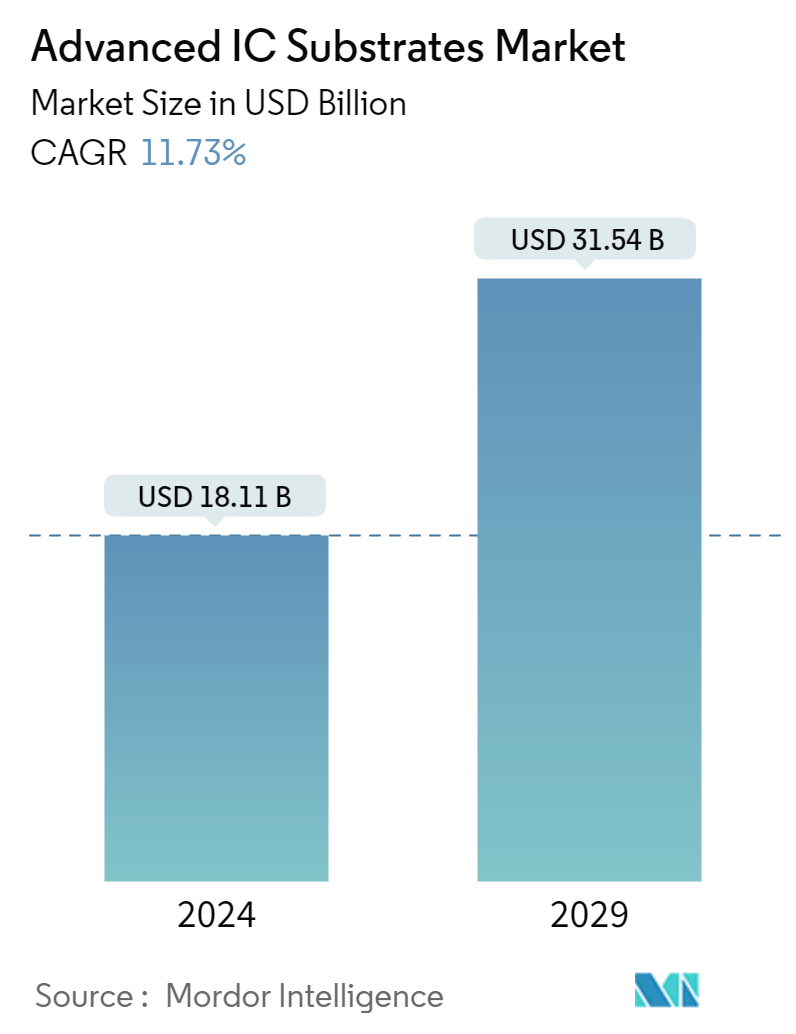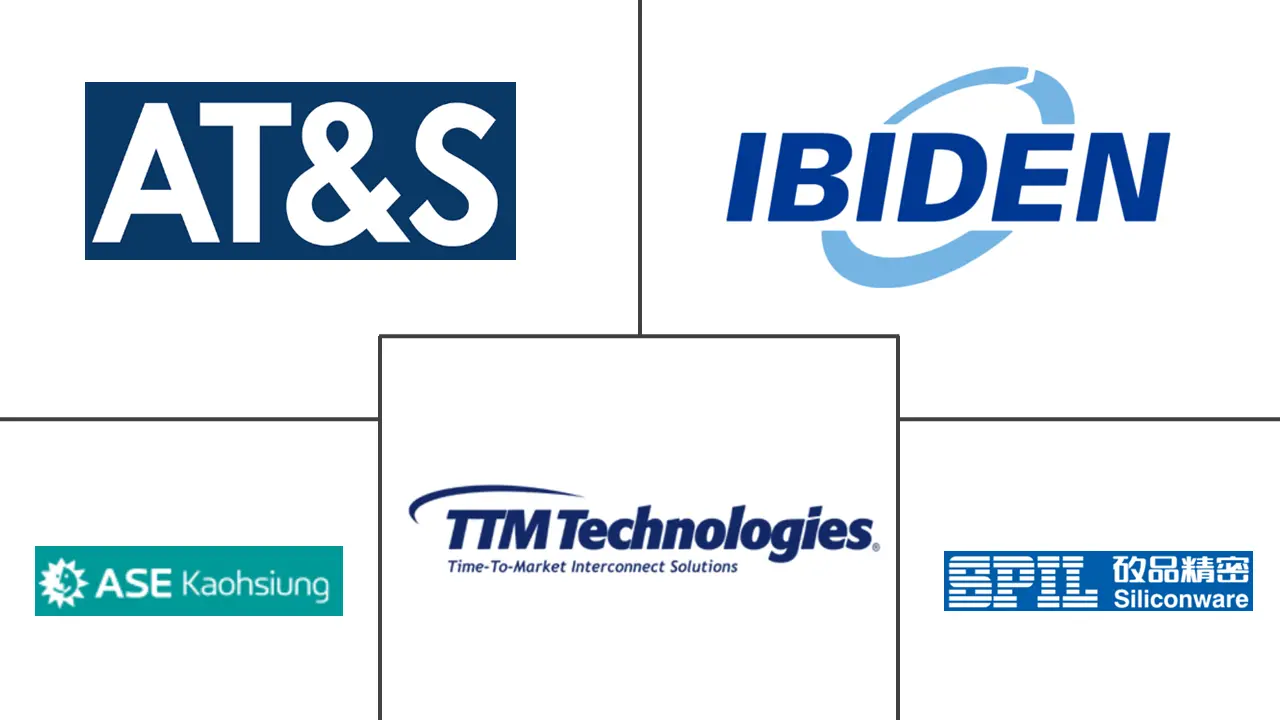Market Size of Advanced IC Substrates Industry

| Study Period | 2019 - 2029 |
| Base Year For Estimation | 2023 |
| Market Size (2024) | USD 18.11 Billion |
| Market Size (2029) | USD 31.54 Billion |
| CAGR (2024 - 2029) | 11.73 % |
| Market Concentration | Low |
Major Players
*Disclaimer: Major Players sorted in no particular order |
Advanced IC Substrates Market Analysis
The Advanced IC Substrates Market size is estimated at USD 18.11 billion in 2024, and is expected to reach USD 31.54 billion by 2029, growing at a CAGR of 11.73% during the forecast period (2024-2029).
- IC substrates play a crucial role in connecting IC chips to the PCB by utilizing a conductive network of traces and holes. They are essential for supporting various functions like circuit support, protection, heat dissipation, and signal and power distribution. The advancement in IC technology, with the introduction of new types like BGA and CSP, has led to the evolution of IC substrates to accommodate different package carriers. The increasing demand for 5G-enabled smartphones and growing investments in the field of smart wearables are expected to drive the market's growth.
- Ever since the electronics industry embraced IC substrates a few decades ago, they have been utilized in various applications, ranging from personal computers and smartphones to high-performance computing (HPC) and other electronic systems. The substrate technology has progressed from early lead frame, wire-bonding ball grade array (BGA), and chip scale packaging (CSP) to flip chip (FC) BGA, FCCSP, and even more advanced technologies like CoWoS, embedded die in IC substrate. The increasing demand for global IoT is driven by both consumer and industrial industries. In these industries, the demand for IC substrates is also rising due to the expanding applications of the technology.
- As artificial intelligence (AI), machine learning (ML), and 5G networks continue to advance, the volume of data being generated increases substantially each year. This rapid expansion of data will necessitate the enhancement of current networking, data processing, and storage systems, leading to a greater need for high-speed and high-frequency devices. Consequently, miniaturization, increased integration, and improved performance have emerged as crucial technological priorities for the development of advanced substrates. Numerous companies have made investments in advanced substrates to cater to the growing global market demand.
- The advanced IC substrates market has experienced notable expansion, given its reliance on the continued growth of high-end smartphones. With the market for smartphones and consumer electronics reaching a saturation point, manufacturers of substrates are striving to broaden their market reach by enhancing technology processing to improve performance and form factor. Consequently, the integration of SLP technology in high-end consumer electronics like smartwatches and tablets is expected to propel the use of advanced IC substrates.
- Advancements in automotive technology are propelling the semiconductor industry and its packaging applications. With the emergence of smart vehicles that enable autonomous driving and various driver-assisted functionalities, the demand for innovative packaging solutions is on the rise. The shift toward electric vehicles on a global scale is also contributing to the growth of advanced packaging technologies, consequently boosting the market for advanced IC substrates. For instance, As per the International Energy Agency (IEA), in the Net Zero Scenario, electric vehicle sales are projected to account for approximately 65% of the total car sales by 2030. Furthermore, the global electric vehicle fleet is expected to grow significantly, reaching a staggering 350 million vehicles by the same year.
- In February 2023, Samsung Electro-Mechanics created an automotive semiconductor package on an FC BGA substrate specifically for driving assistance systems, expanding the range of chip products that can be used in automobiles. Advanced driver assistance systems (ADAS), one of the most technically difficult automotive semiconductor substrates to develop, can be used with its flip-chip ball grid array (FCBGA). Although many of Samsung Electro-Mechanics' FCBGAs were used in PCs and smartphones, the new FCBGA will be used for high-performance autonomous driving.
- Furthermore, the implementation of different government programs aimed at boosting the local production of electronic components and fostering domestic manufacturing is projected to significantly influence the expansion of the advanced IC substrates market. Additionally, South Korea introduced the K-Chips Act in March 2023, allocating a substantial investment of USD 422 billion toward chips and other strategic industries. Such government initiatives in boosting local production across other countries like Malaysia, India, and the United States are expected to increase the demand for advanced IC substrates in the coming years.
- The market encounters various obstacles, extending beyond technical hurdles. It is confronted with exceptionally rigorous technical demands and numerous patent limitations, which have established a formidable benchmark. The establishment, production, and subsequent functioning of the IC substrate production line all demand substantial financial investment, with equipment capital investment being the most substantial aspect.
- The COVID-19 pandemic led to significant shifts in the market foundations, impacting customer behavior, business revenues, and corporate operations. This crisis expedited the integration of automation and Industry 4.0 technologies in factories, driving growth in the chip industry and boosting sales. Due to the pandemic, there was a notable increase in the demand for semiconductor chips across various industries, fueling the necessity for advanced IC substrates.
Advanced IC Substrates Industry Segmentation
IC substrates serve as the connection between the IC chip(s) and the PCB through a conductive network of traces and holes. IC substrates support critical functions, including circuit support and protection, heat dissipation, and signal and power distribution.
The advanced IC substrate market is segmented by type, application, and geography. By type, the market is divided into FC BGA and FC CSP. By application, the market is segmented into mobile and consumer, automotive and transportation, IT and telecom, and other applications such as healthcare, infrastructure, aerospace, and defense. By geography, the market is segmented into the United States, China, Japan, South Korea, Taiwan, and Rest of the World. The market sizes and forecasts are provided in terms of value (USD) for all the segments.
| By Type | |
| FC BGA | |
| FC CSP |
| By Application | |
| Mobile and Consumer | |
| Automotive and Transportation | |
| IT and Telecom | |
| Other Applications |
| By Geography | |
| United States | |
| China | |
| Japan | |
| South Korea | |
| Taiwan | |
| Rest of the World |
Advanced IC Substrates Market Size Summary
The advanced IC substrate market is poised for significant growth, driven by the increasing demand for miniaturized and high-performance electronic devices. As consumer electronics and mobile communication devices become more compact and portable, the need for advanced packaging solutions is escalating. The advent of 5G technology has further fueled this demand, particularly with the use of Flip-Chip Ball Grid Array (FCBGA) in 5G base stations and high-performance computing systems. Key industry players, including Unimicron, ASE Group, and IBIDEN, are investing heavily in research and development to enhance their substrate capacities and meet the evolving market requirements. The market is also witnessing a shift towards Fan-Out Wafer Level Packaging (FOWLP) due to its streamlined manufacturing process and reduced dependency on substrate suppliers.
The global push towards smart devices, IoT, and Industry 4.0 is expected to bolster the demand for advanced IC substrates across various sectors, including automotive, telecommunications, and consumer electronics. China's aggressive strategy to bolster its semiconductor industry, supported by substantial government investments, is anticipated to significantly impact the market landscape. The country's focus on achieving self-sufficiency in semiconductor production by 2025 is driving the demand for advanced substrates. Additionally, the introduction of innovative technologies, such as glass cores by SCHMID Group and Intel, is set to enhance the performance and flexibility of IC substrates, catering to the burgeoning needs of data centers, AI, and high-speed computing applications.
Advanced IC Substrates Market Size - Table of Contents
-
1. MARKET INSIGHTS
-
1.1 Market Overview
-
1.2 Industry Attractiveness - Porter's Five Forces Analysis
-
1.2.1 Bargaining Power of Suppliers
-
1.2.2 Bargaining Power of Consumers
-
1.2.3 Threat of New Entrants
-
1.2.4 Threat of Substitutes
-
1.2.5 Intensity of Competitive Rivalry
-
-
1.3 Industry Value Chain Analysis
-
1.4 Impact of Macro Economic trends on the Industry
-
-
2. MARKET SEGMENTATION
-
2.1 By Type
-
2.1.1 FC BGA
-
2.1.2 FC CSP
-
-
2.2 By Application
-
2.2.1 Mobile and Consumer
-
2.2.2 Automotive and Transportation
-
2.2.3 IT and Telecom
-
2.2.4 Other Applications
-
-
2.3 By Geography
-
2.3.1 United States
-
2.3.2 China
-
2.3.3 Japan
-
2.3.4 South Korea
-
2.3.5 Taiwan
-
2.3.6 Rest of the World
-
-
Advanced IC Substrates Market Size FAQs
How big is the Advanced IC Substrates Market?
The Advanced IC Substrates Market size is expected to reach USD 18.11 billion in 2024 and grow at a CAGR of 11.73% to reach USD 31.54 billion by 2029.
What is the current Advanced IC Substrates Market size?
In 2024, the Advanced IC Substrates Market size is expected to reach USD 18.11 billion.

